It remains a long cherished dream of every IT professional, be it in software development or in testing / QA, to be a team lead followed by the position of project manager. The span of such a journey varies from person to person being commensurate with his/her skills acquired over the passage of time.
 With years of hands-on experience on IT projects, one acquires in a natural way, traditional skills of communication, basic management, man management, agile methods, requirements engineering, software development process etc., yet that’s not enough for being an effective project manager.
With years of hands-on experience on IT projects, one acquires in a natural way, traditional skills of communication, basic management, man management, agile methods, requirements engineering, software development process etc., yet that’s not enough for being an effective project manager.
In the era of Agile, the project management profession is evolving fast with greater importance of applying modern techniques in smartly tackling the problems. Larger corporate houses do prefer Project Management Professionals with certifications like PMI PMP etc. Although prestigious PMI PMP certification is a bit expensive and demanding with 4500 hours of experience, there is no reason to get disheartened! You can opt for the entry-level CAPM certification being a comparatively comfortable route to the Project Management.
If you are not ready to go for either of the certifications, you can still polish your skills on Project Management and can excel in your career progression by studying from rich resources being given to you.
I am in the pursuit for PMI PMP certification and am extremely glad to share the complete knowledge resources as per the latest PMBOK 6th Edition, like practice question papers, articles and video lectures on the Project Management with my tester and developer friends.
Summary of Project Management study material as per PMBOK Guide 6th edition is as under.
PMBOK is a body of knowledge guide which;
• Describes a recognized approach to the project management
• Describes good practice for project management used in an organization may it be IT, Manufacturing or any other sector.
• It also establishes a common lexicon of project management terminology.
• Describes fundamentals for the following exams conducted by PMI:
# PMP
# CAPM
# PgMP
# PMI-ACP
# PMI-RMP
# PMI-SP
• PMBOK Guide is a guide to the Project Management Body of Knowledge
• It covers
# 5 process groups or exam domains
# 49 processes mapped across all process groups and knowledge areas
# 10 knowledge areas that are distributed across Chapter 4 to 13
Chapters of the PMBOK Guide 6th Edition
Chapter 1) Introduction
Chapter 2) Environments in which projects operate
Chapter 3) Role of the project manager
Chapter 4) Integration management
Chapter 5) Scope management
Chapter 6) Schedule management
Chapter 7) Cost management
Chapter 8) Quality management
Chapter 9) Resource management
Chapter 10) Communications management
Chapter 11) Risk management
Chapter 12) Procurement management
Chapter 13) Stakeholder management
5 PMP Exam Domains are:
1) Initiating
2) Planning
3) Executing
4) Monitoring & Controlling
5) Closing
1) Initiate the Project – PMP Exam Domain I
# It covers 13% of the PMP exam with 26 Questions
# It covers 2 processes as per PMBOK Guide
# It describes the following 8 tasks
Initiating Tasks for PMP Exam (8 Tasks) are:
Task 1: Perform project assessment based upon available information, lessons learned from previous projects, and meetings with relevant stakeholders in order to support the evaluation of the feasibility of new products or services within the given assumptions and/or constraints.
Task 2: Identify key deliverables based on the business requirements in order to manage customer expectations and direct the achievement of project goals.
Task 3: Perform stakeholder analysis using appropriate tools and techniques in order to align expectations and gain support for the project.
Task 4: Identify high-level risks, assumptions, and constraints based on the current environment, organizational factors, historical data, and expert judgment, in order to propose an implementation strategy.
Task 5: Participate in the development of the project charter by compiling an analyzing. gathered information in order to ensure project stakeholders are in agreement on its elements.
Task 6: Obtain project charter approval from the sponsor, in order to formalize the authority assigned to the project manager and gain commitment and acceptance for the project.
Task 7: Conduct benefit analysis with relevant stakeholders to validate project alignment with organizational strategy and expected business value.
Task 8: Inform stakeholders of the approved project charter to ensure a common understanding of the key deliverables, milestones, and their roles and responsibilities.
2) Plan the Project – PMP Exam Domain II
# It covers 24% of the PMP exam with 48 Questions
# It covers 24 processes as per PMBOK Guide
# It describes the following 13 tasks
Planning Tasks for PMP Exam (13 Tasks) are:
Task 1: Review and assess detailed project requirements, constraints, and assumptions with stakeholders based on the project charter, lessons learned, and by using requirement gathering techniques in order to establish detailed project deliverables.
Task 2: Develop a scope management plan, based on the approved project scope and using scope management techniques, in order to define, maintain, and manage the scope of the project.
Task 3: Develop the cost management plan based on the project scope, schedule, resources, approved project charter, and other information, using estimating techniques, in order to manage project costs.
Task 4: Develop the project schedule based on the approved project deliverables and milestones, scope, and resource management plans in order to manage timely completion of the project.
Task 5: Develop the human resource management plan by defining the roles and responsibilities of the project team members in order to create a project organizational structure and provide guidance regarding how resources will be assigned and managed.
Task 6: Develop the communications management plan based on the project organizational structure and stakeholder requirements, in order to define and manage the flow of project information.
Task 7: Develop the procurement management plan based on the project scope, budget, and schedule, in order to ensure that the required project resources will be available.
Task 8: Develop the quality management plan and define the quality standards for the project and its products, based on the project scope, risks, and requirements, in order to prevent the occurrence of defects and control the cost of quality.
Task 9: Develop the change management plan by defining how changes will be addressed and controlled in order to track and manage change.
Task 10: Plan for risk management by developing a risk management plan; identifying, analyzing, and prioritizing project risk; creating the risk register; and defining risk response strategies in order to manage uncertainty and opportunity throughout the project life cycle.
Task 11: Present the project management plan to the relevant stakeholders according to applicable policies and procedures in order to obtain approval to proceed with project execution.
Task 12: Conduct kick-off meeting, communicating the start of the project, key milestones, and other relevant information in order to inform and engage stakeholders and gain commitment.
Task 13: Develop the stakeholder management plan by analyzing needs, interests, and potential impact in order to effectively manage stakeholders’ expectations and engage them in project decisions.
3) Execute the Project – PMP Exam Domain III
# It covers 31% of the PMP exam with 62 Questions
# It covers 10 processes as per PMBOK Guide
# It describes the following 7 tasks
Executing Tasks for PMP Exam (7 Tasks) are:
Task 1: Acquire and manage project resources by following the human resource and procurement management plans in order to meet project requirements.
Task 2: Manage task execution based on the project management plan by leading and developing the project team in order to achieve project deliverables.
Task 3: Implement the quality management plan using the appropriate tools and techniques in order to ensure that work is performed in accordance with the required quality standards.
Task 4: Implement approved changes and corrective actions by following the change management plan in order to meet project requirements.
Task 5: Implement approved actions by following the risk management plan in order to minimize the impact of the risks and take advantage of opportunities on the project.
Task 6: Manage the flow of information by following the communications plan in order to keep stakeholders engaged and informed.
Task 7: Maintain stakeholder relationships by following the stakeholder management plan in order to receive continued support and manage expectations.
4) Monitor the Project – PMP Exam Domain IV
# It covers 25% of the PMP exam with 50 Questions
# It covers 12 processes as per PMBOK Guide
# It describes the following 7 tasks
Monitoring Tasks for PMP Exam (7 Tasks) are:
Task 1: Measure project performance using appropriate corrective actions.
Task 2: Manage changes to the project by following the change management plan in order to ensure that project goals remain aligned with business needs.
Task 3: Verify that project deliverable conform to the quality standards established in the quality management plan by using appropriate tools and techniques to meet project requirements and business needs.
Task 4: Monitor and assess risk by determining whether exposure has changed and evaluated the effectiveness of response strategies in order to manage the impact of risks and opportunities on the project.
Task 5: Review the issue log, update if necessary, and determine corrective actions by using appropriate tools and techniques in order to minimize the impact on the project.
Task 6: Capture, analyze, and manage lessons learned, using lessons learned management techniques in order to enable continuous improvement.
Task 7: Monitor procurement activities according to the procurement plan in order to verify compliance with project objectives.
5) Close the Project – PMP Exam Domain V
# It covers 7% of the PMP exam with 14 Questions
# It covers 1 process as per PMBOK Guide
# It describes the following 7 tasks
Closing Tasks for PMP Exam (7 Tasks)
Task 1: Obtain final acceptance of the project deliverables from relevant stakeholders in order to confirm that project scope and deliverables were achieved.
Task 2: Transfer the ownership of deliverables to the assigned stakeholders in accordance with the project plan in order to facilitate project closure.
Task 3: Obtain financial, legal, and administrative closure using generally accepted practices and policies in order to communicate formal project closure and ensure transfer of liability.
Task 4: Prepare and share the final project report according to the communications i management plan in order to document and convey project performance and assist in project evaluation.
Task 5: Collate lessons learned that were documented throughout the project and conduct a comprehensive project review in order to update the organization’s knowledge base.
Task 6: Archive project documents and materials using generally accepted practices in order to comply with statutory requirements and for potential use in future projects and audits.
Task 7: Obtain feedback from relevant stakeholders using appropriate tools and techniques and based on the stakeholder management plan in order to evaluate their satisfaction.
10 Knowledge Areas covered in the PMBOK Guide 6th Edition are as under:
1) Integration Management
2) Scope Management
3) Schedule Management
4) Cost Management
5) Quality Management
6) Resource Management
7) Communications Management
8) Risk Management
9) Procurement Management
10) Stakeholder Management
Knowledge area 1 – Project Integration Management (Chapter-4)
(This Knowledge Area has at least one process in each of the 5 Process Groups)
Some of the major terms related to Project Integration Management are:
1) Actions involved in Execution:
# Corrective action — realigns project performance
# Preventive action — ensures future performance
# Defect repair — modifies non-conformance to project requirements
All these actions usually require a change request
2) Knowledge management:
There are Two Types of Knowledge areas
Explicit knowledge – knowledge that can be quickly and easily expressed through conversations, documentation, figures, or numbers. These are the detailed knowledge areas like Project – Integration, Scope, Schedule, cost, quality.
Tacit knowledge – knowledge that’s more difficult to express because it’s personal beliefs, values, knowledge gain from experience, and “know-how” when doing a task. For example, knowledge related to quality control acquired while working on a software development project. It is more in-depth knowledge
3) Integrated change control workflow:
We can get change requests from anywhere in the project. If the changes affect the features and functions of the product they will call for configuration and change management system. This can lead to an integrated change control system or through a change control board. There could be some metric say like any change involving financial impact above $10,000 will go through the change control board or anything which affects the scope, will go through the change control board. However, if there is no change control board, the change shall flow through Integrated change control.
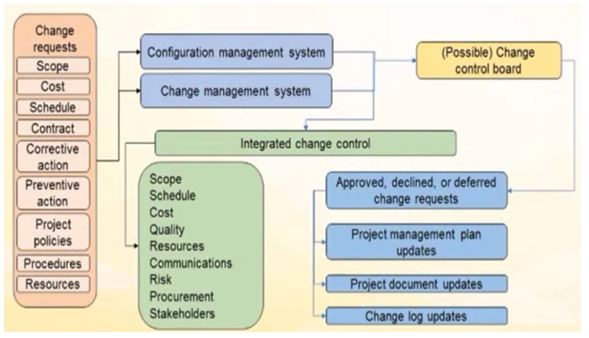
Integrated change control is the examination of what this change will affect on scope, schedule, cost, quality, resources, communications, risk, procurements and stakeholders. So what effect any change is having on the project as a whole. Then the change whether it is done by the “Change control board” or through the “Integrated change control”, the change will then be approved, declined or deferred. If the change is approved, the project management plan is updated and project documents like scope statements, WBS, cost baselines, schedule baselines. Changelogs are also updated with the information of change approved, declined or deferred etc.
Knowledge area 2 – Project Scope Management (Chapter-5)
Comparison of scope under different lifecycles like Predictive Lifecycle and Adaptive or Agile Lifecycle
Predictive Lifecycle – has triple constraints, wherein time and cost vary, while the scope is typically fixed, this is what we have to create, these are the requirements.
Adaptive Lifecycle – refers to Agile triangle of constraints, wherein time and cost is fixed, while scope varies because of the product backlog, priorities change.

Comparison between Project Charter and Project Scope
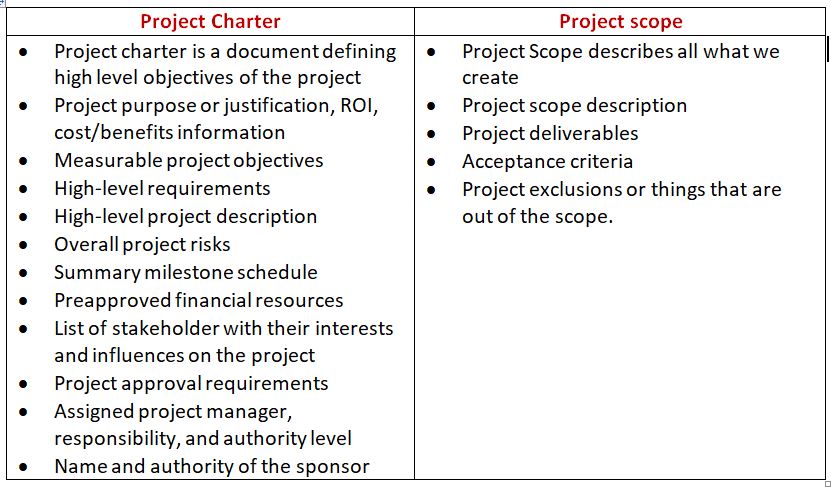
Validate scope:
This is a Project Scope management process used for formally accepting the project deliverables after completion. Its major inputs remain the customer like sign-offs, acceptance of what we are creating.
• It is an inspection-driven process
• The customer inspects the project work
• It can happen in a phase, always at the completion of the project or when any major deliverable is created
• Review, audits, walkthroughs
• Leads to formal project acceptance
Knowledge area 3 – Project Schedule Management (Chapter-6)
Theory of Constraints:
Identifying the bottlenecks in the project which need to be improved.
 • Identifying the most important limiting factor
• Identifying the most important limiting factor
• Systematically improving that constraint until it is no longer the limiting factor
• The constraint is often referred to as a bottleneck
• The scientific approach to improvement
• Lean manufacturing
Dependency Determination:
• Mandatory dependencies have hard logic like activities A, B, and C that need to be performed in a particular order only. These are contractually or legally enforced.
• Discretionary dependencies have soft logic defined by the project team members considering past practices and lessons learned earlier and these can be done in any order as decided by the team.
• External dependencies come in between external or non-project activities and project activities. These dependencies have external constraint beyond our control like dependence on the vendor, waiting for the delivery of the material for doing the work.
• Internal dependencies are also a type of hard logic without any intervention of any external party. These dependencies are defined between two project activities. For example, my project is depending upon your project, that is unless you complete a particular deliverable from your project, I can’t move forward.
Preparation of Schedule Network Diagram:
 • Create network diagram by marking all the activities to completion including durations.
• Create network diagram by marking all the activities to completion including durations.
• Identify and mark the Critical Path – being the sequence of activities that represents the longest path through a project, which determines the shortest possible project duration.
• A project can have more than one Critical Paths.
• Critical Path can change with the advancement of the project.
• Mark the project timing with Forward Pass.
• Mark the Project timing with Backward Pass.
• Calculate float.
Leads and Lags: are more project scheduling terms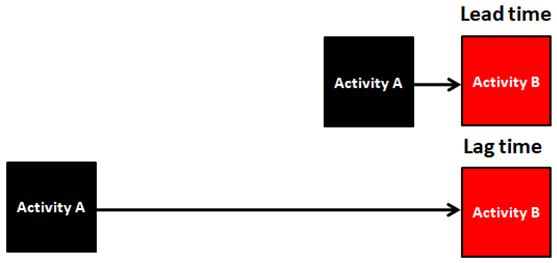 • Lead is an acceleration time of the successor activity and can be used only on finish-to-start activity relationships.
• Lead is an acceleration time of the successor activity and can be used only on finish-to-start activity relationships.
• Lead is negative. 3 days Lead means it is (-3)
• Lead allows activities to overlap
• Lag is a waiting time or delay in the successor activity and can be found on all activity relationship types.
• Lag is positive. 3 days Lag means it is (+3)
• Lag moves activities farther apart
Calculation of float:
The float is of three types
1) Free Float:
• It is the amount of time an activity can be delayed without delaying the Early Start of its successor activity.
• It is calculated at the activity level.
• It defines flexibility of activity w.r.t its successor start.
• (Free Float= ES (of successors) – EF of current activity – 1
2) Total Float:
• It is the amount of time that an activity can be delayed from its early start date without delaying the project completion or finish date.
• It defines the flexibility of a path w.r.t project end date.
• The total float can come into existence if the network diagram has multiple paths and there are activities which are not there on Critical Path.
• Total float for activities on the critical path is Zero
• Total float (Total Float = LS-ES or LF-EF)
3) Project Float:
• It is the amount of time by which a given task within a project can be delayed before it can affect the deadline of the customer expected completion date.
• It is also known as slack.
Using Resource Levelling Heuristics:
• Resource levelling is a technique in which start and finish dates are adjusted based on resource constraints with the goal of balancing demand for resources with the available supply.
• It lays down a cap on all resources how many hours of work
• It generally extends the project schedule
• In the example shown here, everything beyond 50 hours has to be done during the next week
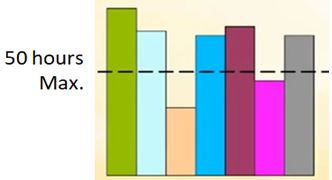 Using Resource Smoothing:
Using Resource Smoothing:
• Resource smoothing is used when the time constraint takes priority. The objective is to complete the work by the required date while avoiding peaks and troughs of resource demand.
• It restricts labor except for the critical path
• It tries to adhere to the deadlines
Knowledge area 4 – Project Cost Management (Chapter-7)
Three-Point Time Estimates (Triangular distribution)
In three-point estimation, three figures are produced initially for every distribution that is required, based on prior experience or best-guesses:
# Optimistic time (O) For example (O) = 25 hours
# Most likely time (ML) For example (ML) = 45 hours)
# Pessimistic time (P) For example (P) = 75 hours
# We finds an average of (O),(ML) & (P)
(O+ML+P)/3=Estimate
(25+45+75)/3=48.33 hours
PERT Time Estimates
# Calculate estimated time using formula
Estimated time = (O+(4ML)+P)/6
• (25+(4*45)+75)/6 = 46.66 hours
• PERT time estimates are better than three-point estimates
Cost Performance Baseline:
The cost baseline is that part of the project baseline that handles the amount of money the project is predicted to cost and on the other side when that money will be spent. It is an approved budget usually in a time distribution format used to estimate, monitor, and control the overall cost performance of the project.
 • It is represented in the form of an S-curve. In the example shown above the blue line represents the cost baseline, the red line represents the actual cost and the black line represents the expenditure.
• It is represented in the form of an S-curve. In the example shown above the blue line represents the cost baseline, the red line represents the actual cost and the black line represents the expenditure.
• Difference between the Blue Line and the Red Line represents the cost variance.
• Stair steps are step by step funding
Knowledge area 5 – Project Quality Management (Chapter-8)
Quality in Project Management :
A quality management process introduced in a project involves typically three phases like quality planning, quality assurance, and quality control.
Quality Planning: Begins with the preparation of a quality plan identifying the quality requirements and standards for the project and product.
Quality Assurance: Refers to auditing the quality requirements and quality control results to ensure appropriate quality standards are used.
Control Quality: Refers to monitoring and recording the results of quality related activities for assessing the performance and prescribe necessary changes.
Meaning of Quality:
Quality is conformance to the requirements. Deming’s cycle of “Plan-Do-Check-Act”– is a standard approach to quality
 Prevention of defects is one of the goals of quality management, that we the work correctly. Quality is planned into a project and is not inspected in.
Prevention of defects is one of the goals of quality management, that we the work correctly. Quality is planned into a project and is not inspected in.
Management has all responsibility for providing all tools and mechanisms to achieve the expected level of quality.
Even zero defects are achievable. For that, we need to slow down the process so much to deploy the right people, the right tools and right resources to achieve zero defects.
Difference between Quality and Grade:
Quality and grade are quite different from each other. If we are satisfied with a product, we would say that this is a high-quality product, and when we are not satisfied with it, we would say that this is a poor quality product. We won’t say that it is a poor grade product.
For example, a low-grade product is not necessarily a problem, the reason being when we purchase a low-grade product, we are very well aware that we are paying for a low-grade product and as such expect the features as per its category.
On the other hand, we would never purchase a low-grade product and expect it to function as a high grade one. For example, if we purchase a mobile phone without any camera, we will obviously not expect it to take pictures.

Type of Quality Costs:

Design For X:
Design for X is also known as DfX.
X is usually a variable that the project is trying to address
# Such as cost, uptime, return on investment
# Considers all components of the design and how the component affects the X variable
# Goals include lowered costs and improved service, reliability, safety, and overall quality
Cause and Effect Diagram:
Cause and Effect diagram involves brainstorming technique for considering all possible causes of a problem, instead of the few most obvious ones before thinking of a solution.
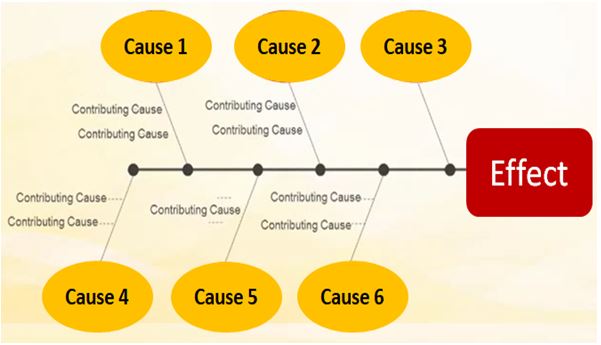
Examining a Control Chart:
Control charts are used to monitor the processes over time and see variation. Control charts help distinguish between common cause and special cause variation in a new process.

Creating a Scatter Diagram:
Scatter diagram is a graphs in which the values of two variables are plotted along two axes to look for a relationship between them. If the variables are correlated, the points will fall along a line or curve. The better the correlation, the tighter the points will hug the line.

1. A positive correlation. As one quantity increases so does the other.
2. A negative correlation. As one quantity increases the other decreases.
3. No correlation. Both quantities vary with no clear relationship.
Creating a Run Chart:
The run chart is a line graph of data plotted over time that is used to find upward and downward trends or patterns in the process.

The run chart doesn’t have control limits; hence it is unable to tell if a process is stable. However, run charts are presenting a general picture of the process.
Knowledge area 6 – Project Resource Management (Chapter-9)
Emotional Intelligence
 • Invest in personal El by improving
• Invest in personal El by improving
# Inbound: Self-management and Self-awareness
# Outbound: Relationship management
• Emotionally competent teams are effective
• Reduction in staff turnover
Resource Terminology
• The role is the generic project team name
• Application developer
• Technical writer
• Authority is the level of decision-making ability
• Responsibilities are actions and expectations to complete work
• Competency is the role’s depth of skills, knowledge, and experience
Matrix Chart :
RACI (Responsible, Accountable, Consulted and Informed) chart.
RACI chart is a matrix of all the activities or decision-making points in an organization by clarifying roles and responsibilities in cross-functional / departmental projects and processes.
At each intersection of activity and role it is possible to assign somebody responsible, accountable, consulted or informed for that activity or decision.
 The accountable person is the individual who is ultimately answerable for the activity or decision. This includes “yes” or “no” authority and veto power.
The accountable person is the individual who is ultimately answerable for the activity or decision. This includes “yes” or “no” authority and veto power.
Only one accountable person can be assigned to an action.
The responsible person is the individual(s) who actually complete the task.
Maslow’s Hierarchy of Needs:
Maslow’s hierarchy of needs is a motivational theory in psychology comprising a five-tier model of human needs, often depicted as hierarchical levels within a pyramid.
As per Maslow people move through different stages of five needs that motivate their behavior. These needs are physiological, security/safety, love, and belonging (social), esteem, and self-actualization.

Herzberg’s Theory of Motivation

McClelland’s Theory of Needs

• David McClelland’s Acquired Needs Theory
• Individual’s needs are acquired over time
• Shaped by life experiences
# Achievement — seeks to excel
# Affiliation — harmonious, acceptance
# Power — personal and institutional
Thematic Apperception Test (TAT)
Creating a Project Team Charter
Charter Defines:
• Team values
• Communication guidelines
• Decision-making process
• Conflict resolution process
• Meeting guidelines
• Team agreements
• Ground rules
• A project team charter is a document which provides clarity and focus.
• It ensures that all members of the project team understand
# what they are supposed to be doing,
# what the purpose of the project is, and
# how they are going to work together to deliver it irrespective of their physical locations
Tuckman Team Development Model
 Forming – Team comes together and high-level formation happens.
Forming – Team comes together and high-level formation happens.
Storming – Possible hostility toward the project leader. challenge ideas.
Debate varies depending on if the project team is willing to work together
Norming – Team accepts their roles and project begins to produce work and settle.
Rely on one another Complete their project assignments
Performing – Team acts cohesively and performs well together following the leaders and achieving results
If a project team can reach the performing stage of team development, they trust one another and work well together, and issues and problems are resolved quickly and effectively.
Adjourning – Task completion, Good feeling about achievement, Recognition
Knowledge area 7 – Project Communications Management (Chapter-10)
Number of Communication Channels

Communications Model:
Communications model is used in facilitating human communication process within the organization. Communication is the process of sending and receiving messages or transferring information from one part (sender) to another (receiver).
Elements of communication process are as under
 • Sender
• Sender
• Encoder
• Medium
• Decoder
• Receiver
• Noise
• Barriers
• Acknowledgments
• Feedback/Response
Knowledge area 8 – Project Risk Management (Chapter-11)
Two Levels of Risk
• Individual project risks
• Overall project risk
• Looking for risk exposure
# Threats
# Opportunities
Prompt Lists:
It is a predetermined list of risk categories that might give rise to individual project risks and that could also act as sources of overall project risk. The prompt list can be used as a framework to help the project team in idea generation when using risk identification techniques.
Overall project risks subscribe to one of three common types of prompt lists:
1) VUCA – Volatility, Uncertainty, Complexity, Ambiguity
2) TECOP – Technical, Environmental, Commercial, Operational, Political
3) PESTLE – Political, Economic, Social, Technological, Legal, Environmental
Probability – Impact Matrix:
A critical part of risk management in projects is creating a contingency reserve. The contingency reserve is time or money allocated to take care of the identified risks. With the help of contingency reserve, the project manager can address the project risks, communicate the severity of risk to the stakeholders, and can enhance the predictability of outcomes of the project.

Contingency Reserve = $52,500 (Sum Total of the values in the last column)
Knowledge area 9 – Project Procurement Management (Chapter-12)
Project procurement management is the creation of relationships with external vendors and suppliers for goods and services required for the successful completion of the project.
Evaluating the Market Conditions
• Sole source
• Single source
• Oligopoly
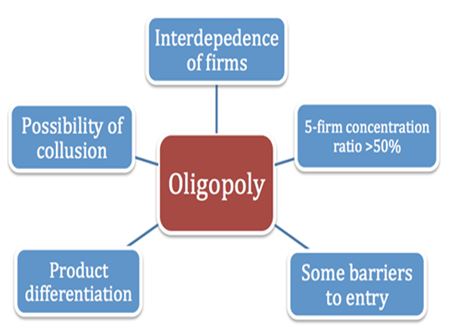
Procurement Process:
Procurement process involves steps like initiating and planning, selecting, contract writing, monitoring, and closing and completing.

All About Contracts:
 • A contract is a formal agreement
• A contract is a formal agreement
• The United States backs all contracts through the court system
• Contracts state all requirements for product acceptance
• Changes to the contract must be formally approved, controlled, and documented
• Contracts can be used as a risk mitigation tool
Contract Legalities
• Fixed Price or Cost Reimbursable
• Contain an offer
• Have been accepted
• Provide for a consideration (payment)
• Be for a legal purpose
• Be executed by someone with capacity and authority
Firm Fixed-Price Contracts (FFP)
• Most common contract
• Seller carries the risk of cost overruns
• Buyer specifies what’s to be purchased
• Changes to the scope
Fixed-Price Incentive Fee Contracts (FPIF)
• Financial incentives for performance
• Cost, schedule, technical performance
• Price ceiling
• Seller carries the risk of overruns
Cost Reimbursable Overview
• Cost plus a fee
• The scope of work can’t be defined early
• High risks may exist in the project
• The buyer carries a risk of overruns
Cost Plus Fixed Fee Contracts (CPFF)
• All allowable costs
• Fixed fee of the initial estimated costs
• Fee paid for completed work
• The fee is constant unless scope changes
Cost Plus Incentive Fee (CPIF)
• All allowable costs
• Fee-based on performance goals
• Incentive sharing (often 80/20)
• Contract defines measurements
Cost Plus Award Fee Contract (CPAF)
• All allowable costs
• Performance criteria for the fee to the seller
• Subjective review by the buyer
• Award is determined by the buyer
Time and Materials Contract (T&M)
• Seller is paid an hourly fee
• Seller is paid for materials
• Not-to-exceed clause
• Time limits for contract
Knowledge area 10 – Project Stakeholder Management (Chapter-13)
Project Stakeholder Management involves identification of stakeholders, analysis of their expectations and influences, development of appropriate strategies to work with the stakeholders and executing the process.
Stakeholders:
Stakeholders are individuals who get impacted by the project. A Stakeholder can be a supporter and a resistor.
Important elements of the stakeholder management process:
1) Active communication with the stakeholders.
2) Understanding the needs and expectations of the stakeholders.
3) Managing the conflicting interest
4) Involvement of stakeholders in important decisions related to the project and activities.
Stakeholders Stakes:
• Interest: affected by the project
• Rights: legal or moral rights
• Ownership: ownership of an asset
• Knowledge: the knowledge that can help
• Contribution: funds, resources, or support of the project
Stakeholder Analysis
 • Power/Interest Grid
• Power/Interest Grid
• Power/Influence Grid
• Influence/Impact Grid
• Salience model
# Power
# Urgency
# Legitimacy
Monitoring Stakeholder Engagement:
• Integrated with other knowledge areas and processes
• Linked to communications
• Communications management plan and schedule
Actively Engaging Stakeholders:
• Relying on the information management system
• Using expert judgment
• Meeting with stakeholders
• Being honest and direct with project news
Data Analysis
• Alternatives analysis
• Root cause analysis
• Stakeholder analysis
Interpersonal and Team Skills
• Active listening
• Cultural awareness
• Leadership
• Networking
• Political awareness
Changes with respect to PMBOK 5th Edition
Following revisions have been affected in New PMBOK 6th Edition
Knowledge Areas Renamed
# Time Management to Schedule Management
# Human Resource Management to Resource Management.
New Processes Added
# Now 49 processes as against 47 earlier.
# Added 3 New Processes:
1) Manage Project Knowledge
2) Implement Risk Response
3) Control Resources
Processes Deleted
# Close Procurements
9 Processes Renamed
Increased focus on Agile approaches
Separate section in every knowledge area
# Approaches for Agile, Iterative and Adaptive Environments.
New chapter added
# “Role of the project manager” with respect to competencies, experience, and skills.
All Articles on PMP Certification and Project Management
Largest Database of PMP Exam Preparation Question Papers

An expert on R&D, Online Training and Publishing. He is M.Tech. (Honours) and is a part of the STG team since inception.
